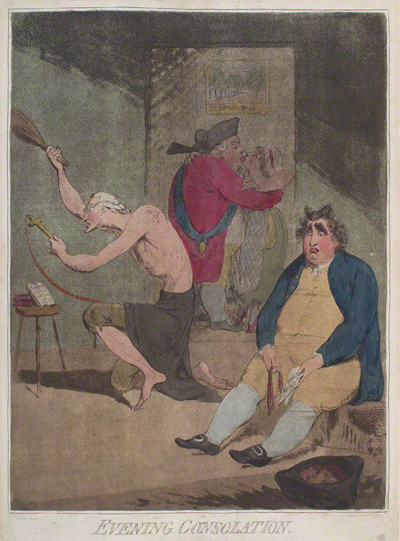Evening Consolation
Evening Consolation is one of two paired prints, satirizing Charles James Fox, Edmund Burke, and Frederick Lord North who had been part of the Fox-North Coalition that had been dismissed in December of 1783 and lost a bid to regain power in March of 1784. First issued in February 1785 when Gillray was still trying to make a name for himself as a "serious" engraver, they were two of only three political prints Gillray created that year. A fourth political print, Ahithophel in the Dumps, was simply a reissue of a print from 1782.
Not surprisingly since Gillray's focus was elsewhere, the satire does not seem to have been prompted by a specific political event, but is directed at the general character of the three men out of office.

© National Portrait Gallery, London
Evening Consolation puports to show Fox, Burke and North at the end of a day, finding solace in familiar and favorite activities. Consistent with Crumbs of Comfort and Cincinnatus in Retirement, Burke is shown in the guise of an ascetic Irish Catholic, finding his consolation in flaggelating himself. The book before him with the title "Reform" suggests both the kind of personal reform that would call for self-flagellation and Burke's involvement with the reform of the East India Company.
Lord North is shown (so far as I can tell wholly without justification) finding consolation in the arms of a lower class prostitute in St. James Park.
A disconsolate Fox is shown still out of office with a copy of "Pitt's Speech" in his hand, out of money (as suggested by his empty purse), and unable to pursue his usual consolation: gambling (as suggested by the dice and box in his hat).
The prints appear to have been reissued two months later, changing February 25th to April 25th perhaps in reaction to Pitt's introduction of a Parliamentary Reform Bill on April 18th. The words "Reform" and "Pitt's Speech" would then have had a much more specific focus.
The prints are among the first to make extensive use of aquatint rather than etched shading lines or cross-hatching. The result is not wholly successful, appearing somewhat muddy and lacking the crisp line of Gillray's earlier prints. But it foreshadows the restless energy and experimentation that Gillray will display when he recommits himself to caricature.
Sources and Reading
- Commentary from the British Museum on Evening Consolation
Comments & Corrections
NOTE: Comments and/or corrections are always appreciated. To make that easier, I have included a form below that you can use. I promise never to share any of the info provided without your express permission.